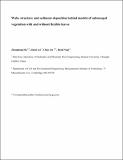| dc.contributor.author | Hu, Zhenghong | |
| dc.contributor.author | Lei, Jiarui | |
| dc.contributor.author | Liu, Chao | |
| dc.contributor.author | Nepf, Heidi | |
| dc.date.accessioned | 2020-02-28T20:46:56Z | |
| dc.date.available | 2020-02-28T20:46:56Z | |
| dc.date.issued | 2018-08 | |
| dc.date.submitted | 2018-05 | |
| dc.identifier.issn | 0309-1708 | |
| dc.identifier.uri | https://hdl.handle.net/1721.1/123897 | |
| dc.description.abstract | This laboratory study explored the flow structure and pattern of deposition directly downstream of submerged patches of vegetation, focusing on whether, or not, the presence of flexible trailing leaves enhanced deposition. Both leaves of different length and patches of different geometry (circular and channel-spanning) were considered. The study defined the length of wake within which the velocity was diminished and net deposition was enhanced. The model sediment represented an organic or mineral solid smaller than fine sand. For a channel-spanning, submerged patch, recirculation or turbulent diffusion in the x-z (streamwise-vertical) plane set the wake length within which velocity was diminished and deposition was enhanced. This length was greater for patches with lower stem densities, because greater flow through the patch displaced the recirculating eddy farther downstream. In addition, for a channel-spanning patch, the presence of flexible trailing leaves extended the wake length, which in turn increased the length of the deposition region. In contrast, for a circular patch, the wake contained oscillations in the x-y (streamwise – lateral) plane. The onset of the wake unsteadiness set the length of the deposition region. Because the presence of flexible trailing leaves on a circular patch did not affect the formation distance for the wake oscillation, the length of the deposition region was unchanged with the addition of the flexible trailing leaves. For both circular and channel-spanning patches, a longer deposition region was associated with a larger deposition mass. Keywords: Aquatic vegetation; Wake structure; Sediment deposition; Ecohydraulics | en_US |
| dc.description.sponsorship | National Science Foundation (Grant EAR-1414499) | en_US |
| dc.language.iso | en_US | |
| dc.publisher | Elsevier BV | en_US |
| dc.relation.isversionof | http://dx.doi.org/10.1016/j.advwatres.2018.06.001 | en_US |
| dc.rights | Creative Commons Attribution-NonCommercial-NoDerivs License | en_US |
| dc.rights.uri | http://creativecommons.org/licenses/by-nc-nd/4.0/ | en_US |
| dc.source | Prof. Nepf via Elizabeth Soergel | en_US |
| dc.title | Wake structure and sediment deposition behind models of submerged vegetation with and without flexible leaves | en_US |
| dc.type | Article | en_US |
| dc.identifier.citation | Zhenghong, Hu et al. "Wake structure and sediment deposition behind models of submerged vegetation with and without flexible leaves." Advances in Water Resources 118 © 2018 Elsevier Ltd | en_US |
| dc.contributor.department | Massachusetts Institute of Technology. Department of Civil and Environmental Engineering | en_US |
| dc.contributor.approver | Heidi Nepf | en_US |
| dc.relation.journal | Advances in Water Resources | en_US |
| dc.eprint.version | Author's final manuscript | en_US |
| dc.type.uri | http://purl.org/eprint/type/JournalArticle | en_US |
| eprint.status | http://purl.org/eprint/status/PeerReviewed | en_US |
| dspace.embargo.terms | N | en_US |
| dspace.date.submission | 2019-04-04T13:24:31Z | |
| mit.journal.volume | 118 | en_US |
| mit.license | PUBLISHER_CC | en_US |
| mit.metadata.status | Complete | |
